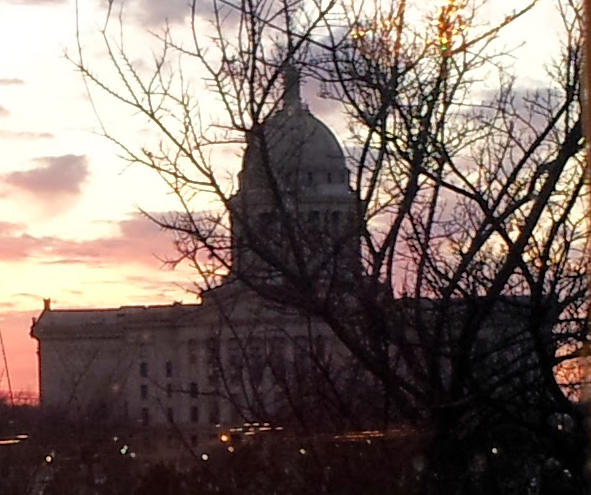Commission Places New State Capitol Monuments on Hold
In August, the American Civil Liberties Union of Oklahoma and the national ACLU filed a lawsuit challenging the constitutionality of the state's Ten Commandments Monument. The action, filed in Oklahoma County District Court, seeks to have the monument removed, citing a constitutional prohibition on using state property to support particular religions or sects. "We must ensure that Oklahoma welcomes people of all faiths and those of no faith at all," said Brady Henderson, ACLU of Oklahoma Legal Director. "Our suit asks the court to enforce a simple and fundamental rule -- that the government does not get to use its vast power and influence to tell you what you should believe."
In November, the New York-based Satanic Temple said the display of the Ten Commandments opened the door for it to seek its own display. That was followed by proposals from a Hindu leader in Nevada, the People for the Ethical Treatment of Animals (PETA), and the not so serious Church of the Flying Spaghetti Monster.
While the Satanic Temple acknowledges that their effort is intended to highlight what it says is the hypocrisy of state leaders in Oklahoma, the group says it is serious about erecting a monument. They have obtained pledges for nearly half the $20,000 needed to build the monument. In January, the satanic group unveiled a design for a 7-foot-tall statue of Satan presented as Baphomet, which is a goat-headed figure with horns, wings, and a long beard that is often used as a symbol of the occult. The Satan figure is seated on a throne topped by a pentagram and is flanked by two adoring children.
Thompson said the ban on approval of new monuments would not affect a state senator's plans to erect a privately funded Bill of Rights Monument. Senate Bill 1159 by Sen. Patrick Anderson (R-Enid) would allow a monument recognizing the importance of the Bill of Rights to be placed on the grounds of the State Capitol. Costs associated with the project would be paid for with private donations. "This is a unifying project that Republicans and Democrats in the House and Senate have embraced," said Anderson. The proposal is part of a nationwide effort by The Bill of Rights Monument Project, a 501(c)3 charity, to place similar monuments on the grounds of every State Capitol. Arizona dedicated the first monument to the Bill of Rights at their State Capitol on December 15, 2012.
The Liberty Institute is assisting the Oklahoma Attorney General in defending the Ten Commandments display against the ACLU lawsuit. "We believe Attorney General Pruitt and his top notch legal team will do an outstanding job defending the State of Oklahoma and leading on this case and Liberty Institute looks forward to assisting them in this matter," said Hiram Sasser, Director of Litigation for the Liberty Institute.
The organization says it's no surprise that the ACLU filed this lawsuit. The anti-faith organization, and other atheist groups, declared their criticism of the monument just days after it was placed on the Capitol grounds. The ACLU and others have made it their mission to eliminate any trace of religion from public view. Legislative prayer, city-sponsored senior wellness centers, town Christmas displays, sacred veterans memorials, and nothing is safe from their attacks. The Liberty Institute is the largest legal organization dedicated solely to defending and restoring religious liberty in America.
Oklahoma state Rep. Mike Ritze (R-Broken Arrow) proposed legislation for the privately funded Ten Commandments monument in 2009. House Bill 1330 received bi-partisan support from both the state House and the Senate, with former Democratic Gov. Brad Henry signing the bill into law. The law specifically authorizes the Liberty Institute to "prepare and present a legal defense of the monument."
The six-foot-tall monument was paid for with $10,000 donated by Rep. Ritze and his family, plus another $10,000 raised privately. The monument is modeled after the Ten Commandments Monument displayed outside the Texas state Capitol. In 2004, the U.S. Supreme Court held that identical Ten Commandments monument constitutional in Van Orden v. Perry, a case that the Liberty Institute assisted the Texas Attorney General in defending.
The Oklahoma legislation establishing the monument recognizes: "1. That the Ten Commandments are an important component of the foundation of the laws and legal system of the United States of America and of the State of Oklahoma; 2.That the courts of the United States of America and of various states frequently cite the Ten Commandments in published decisions; and 3.Acknowledgments of the role played by the Ten Commandments in our nation's heritage are common throughout America."
The monument displays the text of the Ten Commandments and also includes three Christian symbols: the Eye of Providence (also known as the all-seeing eye of God) that denotes the holy trinity, a Chi-Rho (two Greek letters that form a monogram for Christ), and two Stars of David.
In 2009, the U.S. 10th Circuit Court of Appeals ordered that a similar monument on the Haskell County courthouse lawn be removed alleging it violated the First Amendment. That decision was upheld a year later by the U.S. Supreme Court. Sasser said the Haskell County and the State Capitol situations have significant differences. "This monument is different because it has a different history, purpose and context. This monument is legally the equivalent of the Ten Commandments monument the U.S. Supreme Court approved in 2005 in Van Orden v. Perry and is currently sitting on the Texas Capitol grounds," Sasser said. "The bottom line is the state (Oklahoma) basically tracked and followed everything that the Supreme Court said in Van Orden v. Perry. There's a big difference between a situation where you've got a government entity trying to follow the law and do the right things versus one that's just not doing that. I think that's the lesson here. The state of Oklahoma just wanted to make sure they followed Supreme Court precedent to the letter, and that's what they did."
The lawsuit says that because no other monuments are around the one for the Ten Commandments, the state is endorsing a particular religious message. The Oklahoma Capitol Preservation Commission oversaw placement of the monument on the north side of the building. The state's response brief, filed on September 13 by Attorney General Scott Pruitt's office, said the Capitol Preservation Commission identified the location on the north side of the building for the beginning phase of a park in which additional monuments could be added. Also located north of the building is the Indian Flags Plaza representing all of the American Indian tribes in Oklahoma.
The plaintiffs in the lawsuit are not the proper parties to sue, Oklahoma said in the court filing. Attorney General Scott Pruitt's office said the office will provide more details about why it believes the plaintiffs lack standing in later court filings. Henderson said he is confident the plaintiffs have standing to bring the lawsuit because they are taxpayers and residents of Oklahoma.
The case is Prescott v. Okla. Capitol Preservation Commission, Oklahoma County. The lead plaintiff in the lawsuit, Bruce Prescott of Norman, is an ordained Baptist minister and theologian. He is executive director of Mainstream Oklahoma Baptists. Prescott once had an avowed witch as a guest on a Norman radio program he hosted several years ago. Other plaintiffs in the case include Jim Huff, a former educator from Oklahoma City, retired businessman Donald Chabot, also of Oklahoma City, and former social studies teacher Cheryl Franklin, of Enid. The case has been assigned to District Judge Tom Prince.










Latest Commentary
Thursday 31st of July 2025
Thursday 31st of July 2025
Thursday 31st of July 2025
Thursday 31st of July 2025
Thursday 31st of July 2025
Thursday 31st of July 2025
Thursday 31st of July 2025
Thursday 31st of July 2025
Thursday 31st of July 2025
Thursday 31st of July 2025
Thursday 31st of July 2025